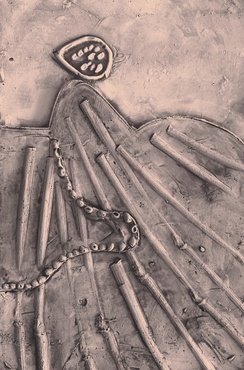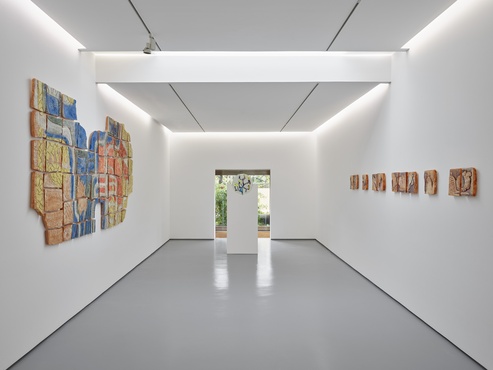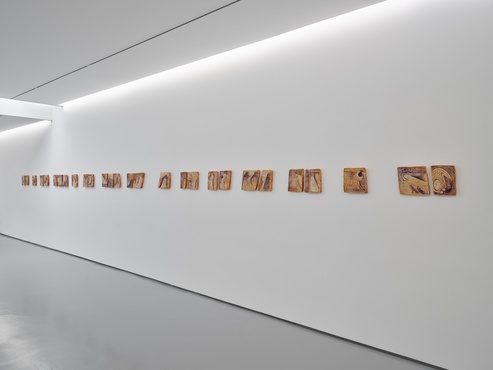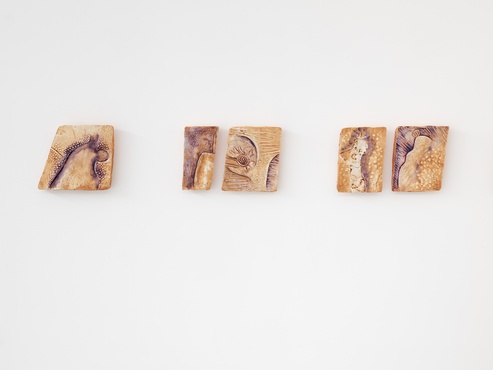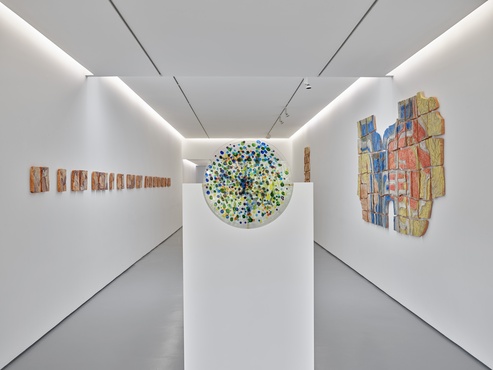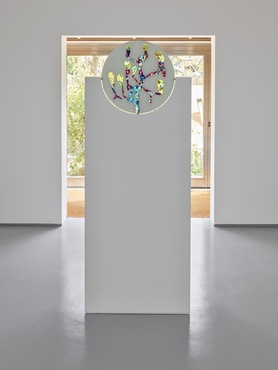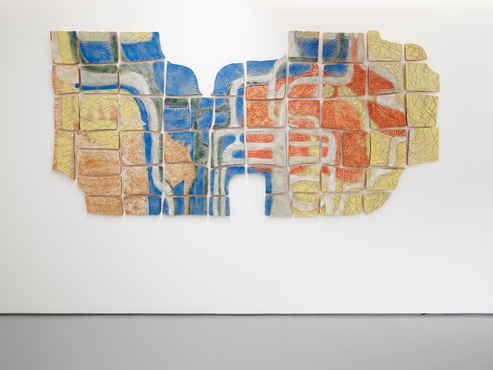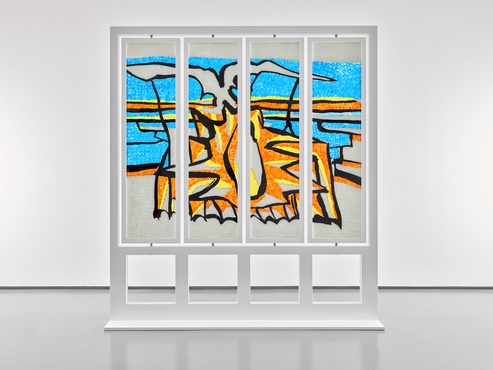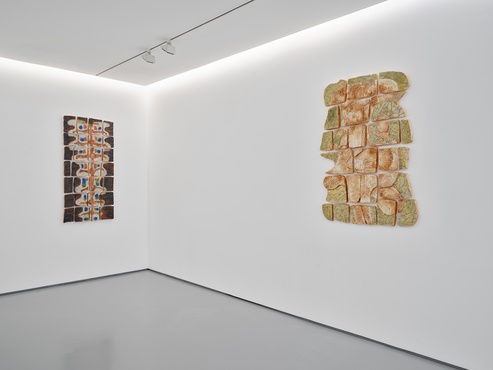Opening | 24th september| 4pm
In
the exhibition Museu Mineiro (Mining Museum), Isabel Carvalho continues her research on the
notion of "nuclear", especially on Portugal's historical involvement
in the controversial debate about its uses and the effects of this energy in
the international context. Combining real facts, past and present, and fiction,
in June 2022 the artist presented in The Grotto (Galeria Quadrado Azul, Lisbon)
the first moment of this project, composed by the reading of a short story of
her authorship and a sculpture, both entitled "The Grottos Community. New
findings", where she approached the permanence of an American agency of
seismographic detection of nuclear tests located in V. N. Gaia. She is now
showing a body of work in Oporto, which takes as a starting point the claims of
the population of Urgeiriça, in Viseu, for a Museum that does justice to their
mining past. As has been evident in her career, the working process begins with
a literary text that serves as a reference. This time, the text is a second
short story by the author that has been written along with the construction of
the works on display.
UM MUSEU MINEIRO (A Mining
Museum)
We have passed,
on a daily basis, by windows such as those of trains, of houses, and of those
others where I now try to research the subject of the "nuclear".[1] These are
framed glass windows, filled with shifting configurations of light and color,
moving rapidly while revealing fleeting realities. As I open them,
sequentially, I receive an explosion of particles that bring me different
perspectives, testimonies, and imaginaries coming from afar[2]
and revealing that nuclear power is something not concrete, that cannot be
seen, or touched, that goes through everything in a discreet way, and that is
factually lethal. By noting these characteristics, under a kind of vertiginous
attraction, I try to understand the scope of its manifestations. The discursive
apparatus around "nuclear" is indeed gigantic. I grasp only a small
piece and delude myself into thinking that I may be close to understanding the
potential of its various dimensions and levels, for the windows, though
translucent, are simulacra, deceptions of the gaze, and there is (always has
been) not much transparency in the mediation of this subject. In this way, I
witness only a flux of data that is harmful when the information is not
accurate. Moreover, the perspective that each window gives us is only a
fragment. But it is possible that the most appropriate approach to this
invisible and impalpable materiality is to keep accumulating small pieces –
fragments – in order to create a kind of mosaic and do a sort of an historical
reconstitution.
It is probable that the idea of
speaking of "nuclear" departing from windows has arisen from the
impression caused precisely by having read a short testimony from someone who,
through them, witnessed the spectacle caused by nuclear explosions, which, at
first, appeared as something magical, similar to a festive firework, a display
of visually stunning lights and colors, but who then felt up close the death
caused by the radioactive effect on the bodies and how they silently rotted
away.[3] What is
certain is that there is, from the very beginning of its use, an approximation
between the nuclear apparatus and aesthetics.[4]
In the current context of war, we are witnessing the occupation of the main nuclear power plants in Europe and successive threats that call us, through generations, to revisit the past under this danger, as if it were the inescapable imaginary of the end of the world, of human extinction, which seems to us, ironically, cohesive and familiar at last. It is a globally distressing situation because we already know enough about what is at stake and what the consequences for life on this planet are. My effort has been to dissolve fear (a feeling so present and instrumentalized in discussions about "nuclear") by turning my attention inward: either to the body, or to that same body located in a certain space. To guide me, I started to formulate the following question: what is the (political) role, widely assumed to be as neutral, of "our" geographical position? For a moment, I’ve remembered that for several years in the beginning of the 21st century, my family and I spent our vacations in a hotel located right in front of the deactivated mines of Urgeiriça, in Viseu. This town appeared in the news at that time because the population boycotted successive elections. The memory is now revived and has taken on a very concrete form. When I returned to Urgeiriça this year, I saw the same streets, already deserted before, but now punctuated by black flags and claiming canvas. The mining population of Urgeiriça demands a Mining Museum that fulfills historical justice, confirming the damage done to their bodies traded for so little, while contributing so much to technological advances and the eventual production of nuclear weaponry. And this is the image that I retained, of a collective desire to restore the truth and to tell another story. The indignation is fair: it is due to the scant information circulating about the damage that resulted from the period of radioactive exposure, the political abandonment of that place and the people who built their lives there, as well as the uncertainty of the future...
Similar examples abound in Portugal,
perhaps less mediatic compared to the geographical areas of other countries
where nuclear accidents have occurred, demonstrating that even in this case,
under the discourse of (false) "neutrality", it is never convenient
to return to the past.
In the article published in 2018, Carnation Atoms,[5]
the "nuclear" issue is associated with the despotism of the Estado
Novo – which not only sold uranium extracted in Portuguese territory as it also
hoped to use the resources of the empire's colonies – and there it is mentioned
that are the civil epistemologies
that emerge already in democracy that are seen, optimistically, as the truly
"anti-nuclear" ones, by confronting the "core" of a
centralized power. The “Festival pela
vida, contra o nuclear” [Festival
for life, against nuclear power] (1978), which took place in Ferrel, is the
paradigmatic case that illustrates how popular mobilization, allied to
scientists (and not astrologers, hippies, as was said to delegitimize the mobilization),
against the installation of a power plant, can win. The fact is that we don't
have nuclear power plants like our neighbors in Spain, but it is
"lyrical" to think that it was in fact the local populations, those
previously erased from History, who managed to sway the already democratically
elected government from its decision. After all, this government was also in
favor of nuclear power, perhaps as a manifestation of its modernized position –
following the opinion that a non-nuclearized country is an underdeveloped
country, since a country does not necessarily use their reserves to its
advantage. Popular mobilization, undoubtedly, has had a strong influence on
nuclear imaginaries, enlightening them, forcing them to expand their limits,
and above all eradicating the cunning lies based on fear, on the need for
protection (the famous "peace atom", during the Cold War), and on
their other dubious benefits. Nothing would pass without a counter-image that
proposed to restore the truth of the facts. Civil
epistemologies were effectively formed from fragmentation, from the
shattering of the "core" – from the former centrality of the
non-self-determined collective plan. In effect, to assume an anti-nuclear
position is to think together, democratically and, in face of an urgency, to
form alliances.
For this exhibition, which I present
as a moment to be continued[6], I
considered it particularly interesting to attend to the epistemological changes
and, inevitably, to the perceptive changes, visions and imaginaries that
reflect a combative position of the body(ies), mainly on the
"anti-nuclear" front. In an apparent explosion of the real along with
the implosion of the bodies – in the perception of themselves, of their
subjectivities, confirming a change to a kind of solidary living and survival that can serve
to model imaginaries about the nuclear – I wanted to create pieces that could
be associated to memory and to how we are haunted by past facts. Visibly, these
pieces (re)present both "things" (bones and lungs, suns, fungi,
tunnels, etc.), as well as the matter of which they are made and their concepts,
resulting in something with a wide degree of uncertainty. My proposal is to
depart from this point using literary fiction exercises, expanding the means
and the space of reflection of the creative process.
Oporto, August 2022.
Isabel Carvalho
[1] Theme of the next Leonorana magazine – an editorial project I have maintained since 2017 – which is currently being worked on by the editorial team composed of Vanessa Badagliacca and supported by José Carlos Marques as a consultant.
[2] The concept of the atom appears already in antiquity, although it was thought of differently.
[3] Alexievich, S. (2016). Vozes de Chernobyl: história de um desastre nuclear. Translation by Galina Mitrakhovich. Lisboa: Elsinore.
[4] When the first tests were conducted on American territory, under the name Trinity, the physicist responsible for the project, Robert Oppenheimer, described the "spectacle", praising the scientific achievement and minimizing the harmful effects of the explosions, recalling a Hindu poem - If the brightness of a thousand suns/ were to burst once in the sky,/ it would be like the splendor of the mighty. The poetic comparison, in the public communication of the occurrence as being in the realm of the sublime, may cause outrage today, but at the time it passed unscathed.
[5] Pereira, T. S., Fonseca, P. F. C., and Carvalho, A. (2018). Carnation Atoms? A History of Nuclear Energyin Portugal. Minerva.
[6] Preceding this
exhibition is the event held in June this year at Gruta – a project by artist
Hugo Canoilas for the Quadrado Azul Gallery, in Lisbon – when I wrote, read and
published, in poster format, a short story entitled “The Grotto Community ...
New discoveries” about Portugal's involvement in international nuclear
policies.
MUSEU MINEIRO
Text by Vanessa Badagliacca
It is only the
full realization of our shared self-destructive behavior, whether of Eastern
or Western bloc, northern or southern hemisphere, which can
adequately move us to a change.
I have called this
change a time to bloom.
Rosalie Bertell, No Immediate Danger. Prognosis for a
Radioactive Earth, 1985
The current climate crisis and consequent urgent necessity to find alternative ways to produce energy, the war in Ukraine started in February this year and bringing to the fore the energetic dependency of some European and Mediterranean countries on fossil fuels imported from Russia, reawakened a concern on nuclear power and nuclear energy. Those are connected with fears evocative of some of the most terrible disasters from the twentieth and twenty-first century, such as the atomic bombs dropped on Hiroshima and Nagasaki, the nuclear accident in Chernobyl, the Fukushima disaster, the nuclear experiments in North Korea, to arrive to the current nuclear threat caused by the war between Russia and Ukraine.
The nuclear imagination, addressed by poet Drew Milne in his “Poetry After Hiroshima? Notes on Nuclear Implicature” (2017), is presently reemerging with its double face for the power and danger it conveys. Just what is it that makes today’s nuclear so easy, so appealing? Borrowing the question from the title of a collage that Richard Hamilton released in 1956 and replacing the original world Home with Nuclear, we may find some prompts for reflection. Through that piece the British artist recognized the domestic space as the main arena to which channel advertising for a new set of commodities, including male and female body as a result of a consumerist society. Both an image of progress and a promise of modernity that goes hand in hand with a possibility of emancipation by external suppliers.
In the path toward improvement of solar and wind energy, nuclear power is seen as an answer to maintain a stable production of these kinds of renewable energy, therefore a useful tool for obtaining a stable value of the so-called clean energies and a contributor to achieving zero emission. The promise of advanced technology to implement it makes it even more appealing, offering an image of up-to-date production of energy compatible with the necessity of individual and industrial needs. However, these kinds of evaluations seem to completely dismiss or conceal the other side of the supposed image of purity and cleanliness that the nuclear energy produced with the most sophisticated technology wish to sell. Clean and pure do not and cannot get rid of the waste coming from uranium. At a time when the benefit of supposed clean energy is promoted as a promise to employ energy that excuses the exploitation of soils and resources that impoverish the Earth, the danger of nuclear waste goes silenced. Nuclear is appealing, clean, modern, and advanced. In a word, it is evolution.
The arts have responded with interest and posing complex questions about nuclear, whether in favour or against it. For instance, in the context of post-war Italy, nuclear power plants installed in the south of Italy at the beginning of the 1950s were considered a way towards industrial development – although without any public political consensus through a vote that would legitimate their installation in the country – and closed immediately after the Chernobyl disaster. That was the social and political environment that gave rise in 1951 to the “Manifesto Della Pittura Nucleare” (“Manifesto of Nuclear Painting”), whose main spokepersons Enrico Baj and Sergio Dangelo at first considered with excitement the possible new horizons offered by nuclear energy. The latter was associated with disrupting academicism in the art field and broadening the borders of the discipline as Futurism or Spatialism aimed to do earlier.
Nevertheless, as art historian Gabrielle Decamous (2011) poignantly pointed out – the interest in the atom within the arts did not appear after the bombing but rather dates from long ago, for instance in Greek philosophy and Latin poetry with Lucretius’ De Rerum Natura which also gave inspiration to Enrico Baj’s series of works. However, Baj did not take long to withdraw from this faith in nuclear to develop an anti-nuclear stance critical to that scenario. It is a fact that the atomic disasters that occurred in the twentieth and early twenty-first centuries have been crucial for artists to take a position regarding the danger – immediate or in the long run – of nuclear energy.
It also seems worthwhile mentioning the anti-nuclear feminist movement rising in the UK and the US by the end of the 1970s in the realm of increased interest in nuclear energy and nuclear power and its consequences. The focus on nuclear and radioactive culture in contemporary art deserves indeed a more extended argumentation. What seems relevant to underscore here is to recognize the set of works that Isabel Carvalho presents at this exhibition in Quadrado Azul gallery as a place to re-think and complexify questions that blurs the borders between art and science, and that also implies a convergence of political, social, and aesthetics stances.
Taking as a point of departure a way for “thinking from” (in Donna Haraway’s words) a situated history that brings her to metaphorically “mine” into her childhood memories, Isabel Carvalho explores a site in the north of Portugal, called Urgeiriça. Intersecting local history and material entanglements that interrogate and ask to take a stance on the role and the “response-ability” (continuing with Haraway's words) that the country had and has with regards to the mining of uranium as raw material for export, this exhibition entangles relations between nuclear industry, nuclear history, and aesthetics. If uranium mining was not and is not considered a nuclear process, it follows that different regulations are applied from those of nuclear power stations, and consequently to the monitoring and safety of the workers and the environment. These complex and political relations are synthesized by historian Gabrielle Hecht (2013) through the concept of “nuclearity”. And – as the title of one of the pieces presented testify – the inhabitants of the village claim a Miner Museum.
The set of works presented by Isabel Carvalho, whether anchored to a specific locale and time, seems to transcend any chronological definition and measure. A dimension of myth, ancient and modern, is convoked in a sort of untimed dimension. After coming across the piece Accidental sun, which immerses us in a double contrast of blue and yellow, we are encapsulated in a kind of timescale that extends from a pre-human to a post-human dimension through the Frieze of geoglyphs, Scintilograhpy, Claiming intra.activity towards the Civil Epistemologies: For a Mining Museum and The little lamps; the last inhabitants. This way, the artist creates symbolic relations between matter and the environmental processes in nuclear landscapes that alter conventional notions of time and space. As Karen Barad pointed out: “The temporality of radiation exposure is not one of immediacy; rather, it reworks this notion, which must then include generations before and to come.” (2017: G109)
The work of Isabel Carvalho evokes images of flourishing anatomy in full power. Breathing, as involuntary and natural as it may seem, connects us to a sort of ancestral way of living on the planet, and yet, in this context of dazzling colour effects, evocations of anatomical parts of bodies on a big scale, instil a sense of trouble and suspicion, that counterbalance a vibrant elegance and sensuality. Drawing with clay – as the artist declared once in her studio – might be considered a sort of printing process, imprinting on a surface to give it a shape.
Metaphorically it could translate the way radioactivity leaves its imprint on the landscape and all those living, lying, and even flying on it. An interrogation of human responsibility towards the past and present use of nuclear that does not attempt to recover a supposed idea of lost nature but rather to try to open toward new understandings to re-inhabit a damaged planet. Addressing social, political and aesthetic questions, the exhibition “Um Museu Mineiro” [A Miner Museum] opens a space for debate, to think about possible ways for a change, to a time to bloom.
Vanessa Badagliacca



